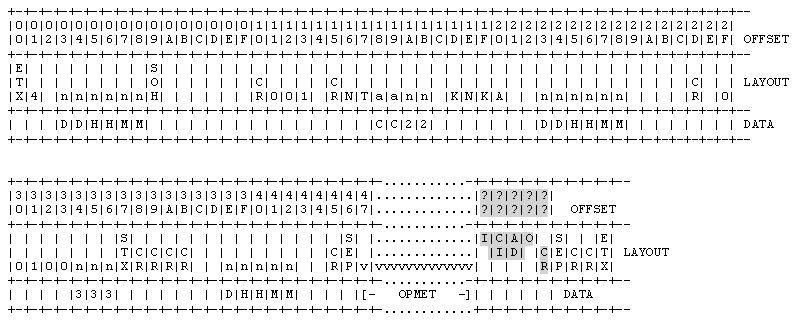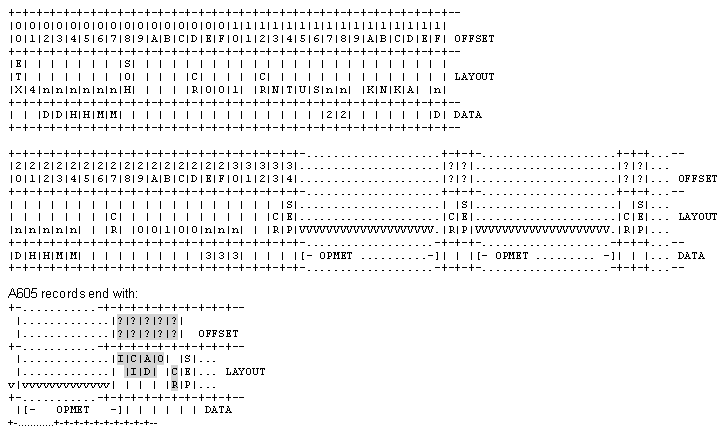OPMET data, including METARs, TAFs, SIGMETs, and other operational meteorological information of interest to aviation users is collected by DTN from various sources around the world. This information is packaged into a single set of files, as described below.
Both domestic US and international NOTAM files are sent in one of two types of files. Every six hours a summary file is distributed which contains a list of all active NOTAMs for every sites in the DTN database. This summary is intended to serve as a master synchronization. Then during the ensuing six hour period, as NOTAMs for individual airports are issued or cancelled, they are contained in the ad-hoc NOTAM files described below.
Layout of binary AdHoc ANWS, AVTN, A604 and A605 Records:
Each AdHoc file can contain multiple records. These records contain binary markers combined with both fixed and variable spaced ascii data.
Each record has the following layout:

The highlighted area in the image above is included for A605 records only.
Where:
The first 2 lines represent the hex offset from the start of the record. (OFFSET)
Lines 3-5 represents the layout of the record with the following conventions: (LAYOUT)
Binary Markers – each represents 1 binary character.
-
ETX = 0x03 = End of Text
-
STX = 0x02 = Start of Text
-
SOH = 0x01 = Start of Header
-
SEP = 0x1E = Record separator
Data:
-
n = fixed length numeric data
-
a = fixed length alphanumeric data
-
v = variable length alphanumeric data
All other characters represent the actual acii character found in the file.
For example, the sequence <ETX>4 at the beginning of each record would be found in the file as the following binary sequence: 03 34 (34 is the character code for ‘4’) and would represent offsets 00 and 01 from the start of the record. The begining of the DayHourMinute would be at offset 03, etc.
NOTE: Spaces matter!
The sixth line identifies what each of the data parts represent. (DATA)
Column1=DayHourMinute DDHHMM – 6 digit number representing the day, hour and minute as 2 digits each
Column2=ShortDayHourMinute DHHMM – 5 digit number representing the last digit of the day as 1 digit and hour and minute as 2 digits each
Column3=Country CC – Country code as 2 digits
Column4=RegionTwo 22 – Region 2 code as 2 digits
Column5=RegionThree 333 – Region 3 code as 3 digits
Column6=NotamText [- NOTAM ……… -] – NOTAM text as variable length string
Layout of binary Summary A604 and A605 Records:
Each Summary file can contain multiple records. These records contain binary markers combined with both fixed and variable spaced ascii data. Each record has the following layout:

Where:
The first 2 lines represent the hex offset from the start of the record. (OFFSET)
Lines 3-5 represents the layout of the record with the following conventions: (LAYOUT)
Binary Markers – each represents 1 binary character.
-
ETX = 0x03 = End of Text
-
STX = 0x02 = Start of Text
-
SOH = 0x01 = Start of Header
-
SEP = 0x1E = Record separator
Data:
-
n = fixed length numeric data
-
a = fixed length alphanumeric data
-
v = variable length alphanumeric data
All other characters represent the actual acii character found in the file.
For example, the sequence <ETX>4 at the beginning of each record would be found in the file as the following binary sequence: 03 34 (34 is the character code for ‘4’) and would represent offsets 00 and 01 from the start of the record. The beginning of the DayHourMinute
would be at offset 02, etc.
NOTE: Spaces matter!
The sixth line identifies what each of the data parts represent. (DATA)
Column0=DateTimeString DDHHMM – 6 digit number representing the day, hour and minute as 2 digits each
Column1=Day DD – 2 digit day
Column2=Hour HH – 2 digit hour
Column3=Minute MM – 2 digit minute
Column4=RegionThree 333 – Region 3 code as 3 digits
Column5=RegionTwo 22 – Region 2 code as 2 digits
Column6=NotamText [- NOTAM ……… -] – NOTAM text as variable length string
NOTAM Summary Use Cases
NOTAM summary files are designed to update end-user databases to either spin-up new users with all active NOTAMs or to recover missed NOTAMs due to distribution errors.
NOTAM summary files are available for both domestic, A604, and International, A605, with the following differences:
-
Domestic
-
Files update three times per day at 0430z, 1230z and 2030z.
-
The file naming convention is the same as the ad-hoc NOTAMs which means no distinction between the data files from a file name perspective. If you receive the ad-hoc files you are receiving the NOTAM summary files.
-
-
International
-
Files update once per day at hhmmz.
-
The file name convention for the summary files differs from the ad-hoc. This is by design so the NOTAM summary file distribution can be controlled and in turn users can retrieve and process NOTAM summary files.
-
There possibilities of differences with the NOTAM summary update and the ad-hoc due to timing. It is expected routine updates of both sets of NOTAM files will keep NOTAM database current.